3. If my work doesn’t have a Copyright symbol, someone can infringe on my Rights
Before the digital era kicked in, a published work is considered copyright protected provided, it had the symbol of copyright on it. In case the work is devoid of this symbol, it automatically opened the doors for the public to use or adapt it. With digital technology seeping into every aspect of our life, during the late 80s, a change of law in the US covered the security of these works, regardless of the affixion of a copyright label on it. Of course, a valid copyright notice on your material will certainly go a long way in informing the public that your work is not copyable just because it is out there in the public domain.
4. Proving Copyright Infringement is too Taxing
Many business owners avoid filing copyright infringement cases as they think taking the infringer to a court or suing them is a tedious process. But in reality, it is not as taxing as one thinks. If you are trying to prove infringement has occurred, two main things to consider here are a. The resemblance that arises between the two works is not coincidental, b. If the infringer strikes back and claims authorship over the work, the actual owner should have a valid registration certificate that provides evidence of the original claim.
Conclusion
Now that we’ve busted some of your myths, you might be interested to know more about how we can help you secure your intellectual rights in the United Arab Emirates (UAE), Gulf Cooperation Council (GCC) region, and the Middle East. Contact us for a complimentary consultation at +971 4 282 2677 or email us at [email protected].





